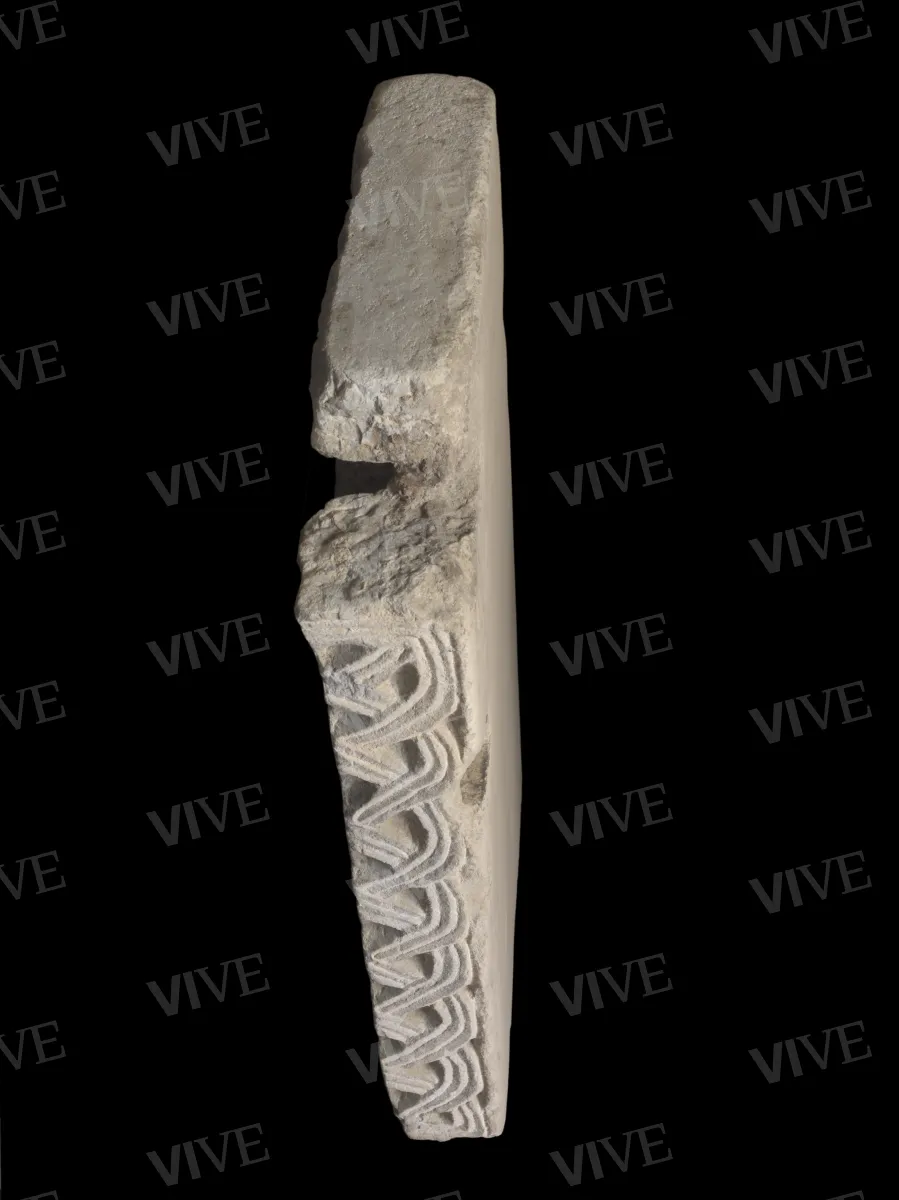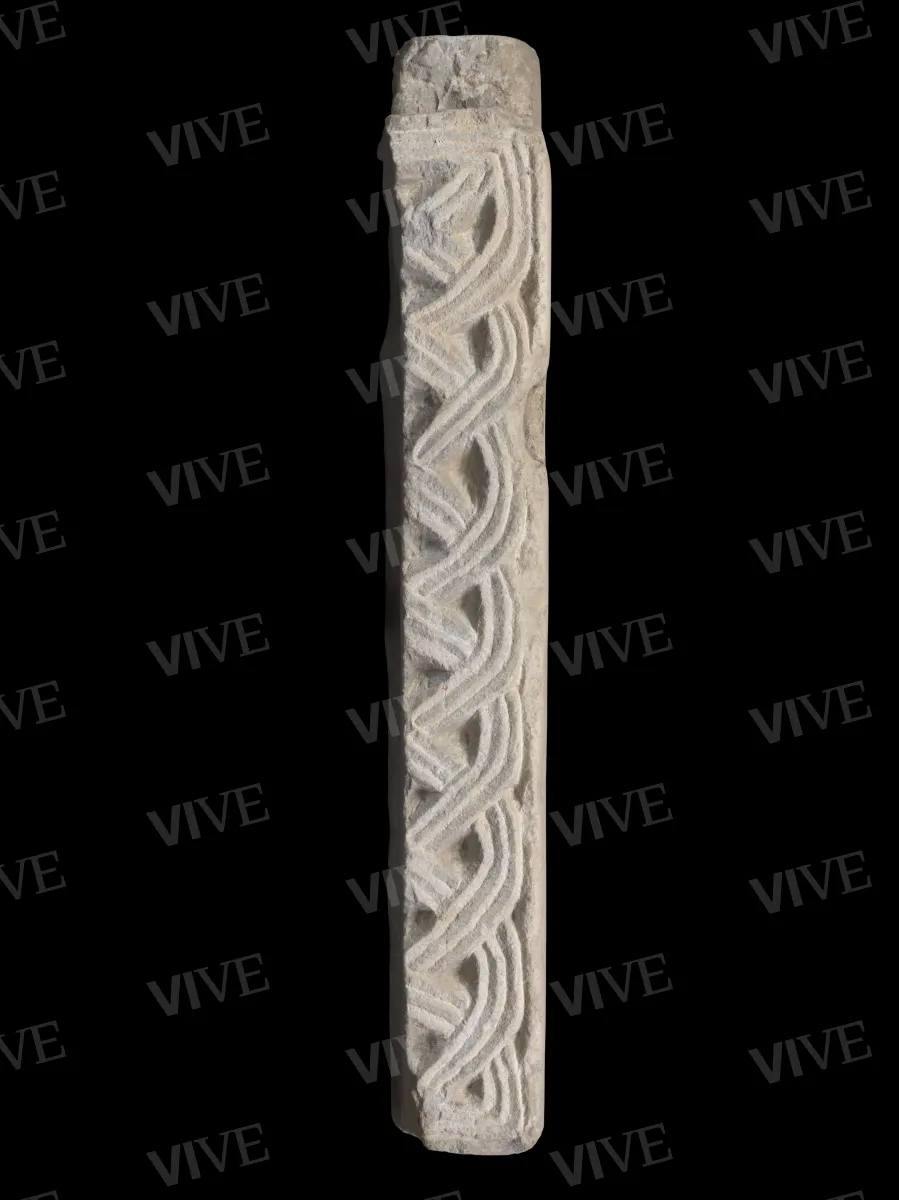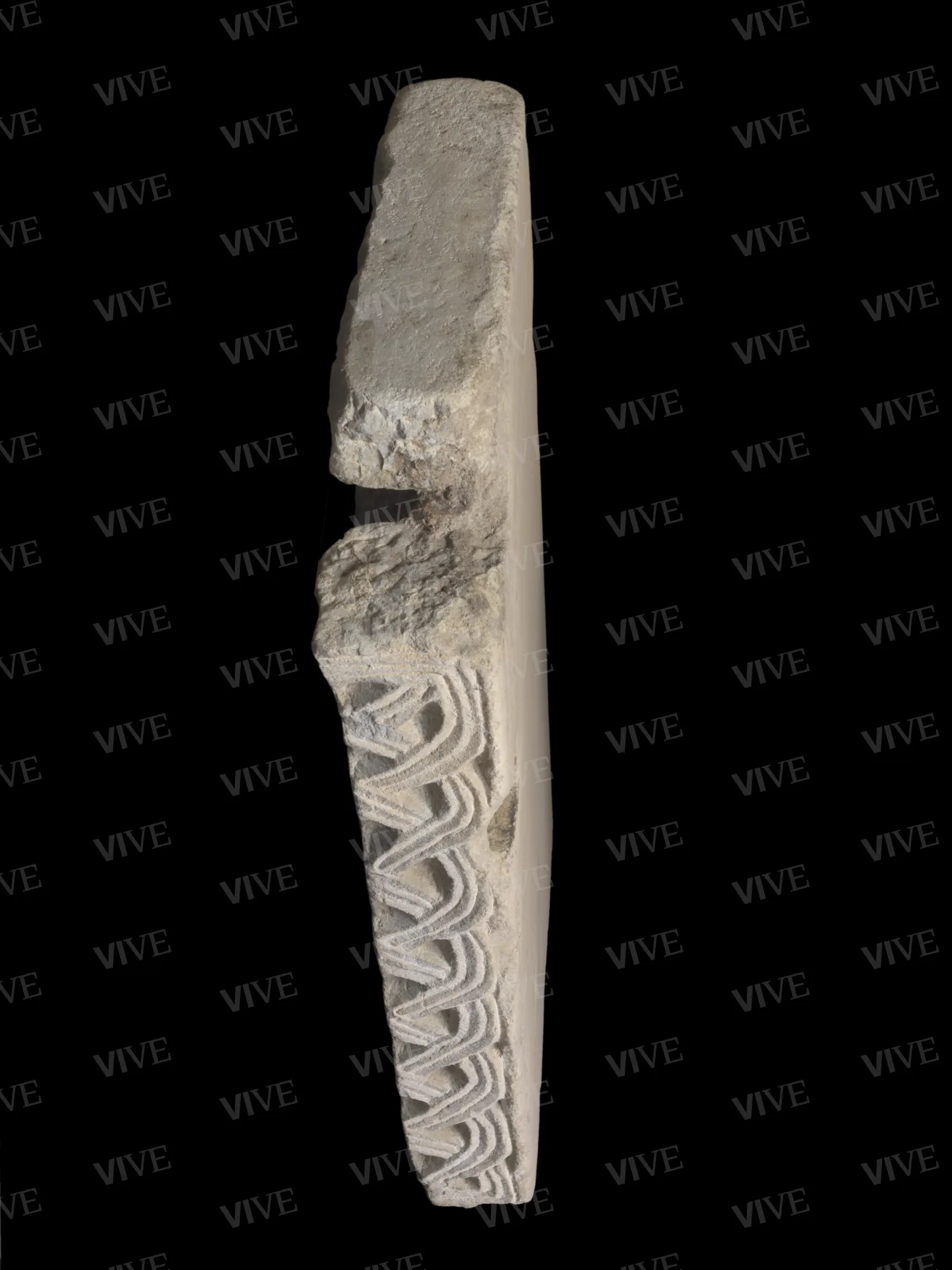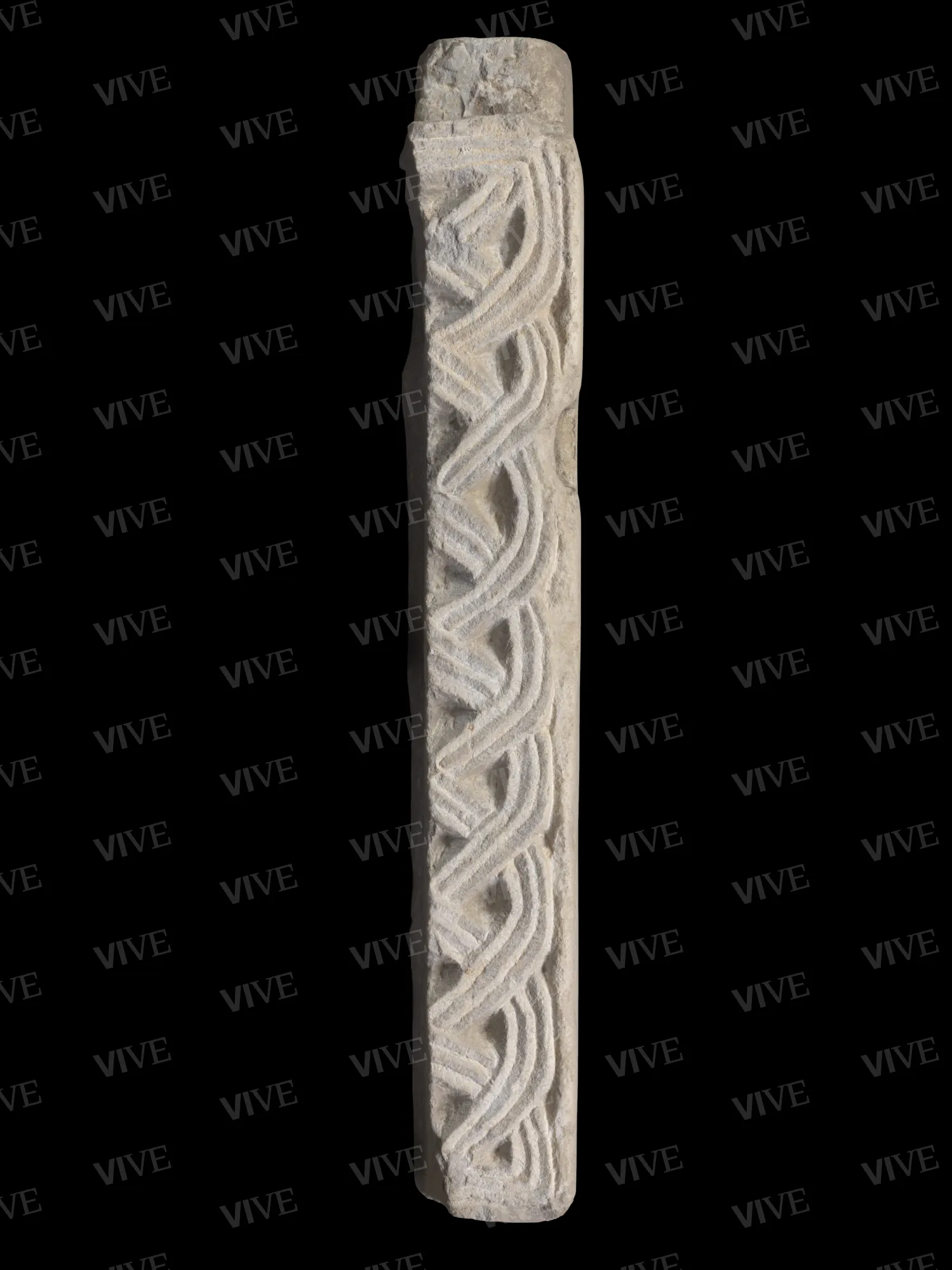Fragment of interlaced architrave
Roman milieu Late-8th–first quarter 9th century
Fragment of marble architrave decorated with a treble braid of two-lined wicker ribbon motif with rectilinear ends and a plain listel frame.
Fragment of marble architrave decorated with a treble braid of two-lined wicker ribbon motif with rectilinear ends and a plain listel frame.
Details of work
Catalog entry
The marble fragment is decorated with a treble braid of two-lined wicker ribbon motif with rectilinear ends and is bordered on three sides by a thin, plain listel frame. The particularly tight braid cross-overs produce ogival eyelets with a shell-like shape, giving the ornament a distinctly colorful effect. Compositionally, the distribution of the wicker ribbon motif links, spaced and regular on the left, becomes more tightly packed and less regular in the last three knots on the right.
The multiple interlace motif (Casartelli Novelli 1976; Casartelli Novelli 2019; Romanini 1975; Romanini 1992) is seen in early medieval Roman sculptural production on considerable occasions due to the development in length that made it easily adaptable to different contexts, such as pilasters, jambs, architraves, and cornices for presbyterial enclosures, ciboriums, and other fittings in buildings of worship from the end of the eighth century, when most of the aniconic interlaced ornament is recorded (Seminario 1976; Paroli 2001), and was widely disseminated in the first quarter of the following century, with elements of continuity between the sites of Leo III (795–816) and Paschal I (817–824) (Ballardini 2008).
What the slab was originally designed for is unknown, and it must certainly have been repurposed, as can be evinced from the clean cut along the base, which effectively halves the overall design, and the presence of chiseling and chipping and even holes.
It is conceivable that the fragment might originally have been linked to an architrave, probably as part of the same liturgical fittings along with the slab with peacocks (inv. 3301) in the Museo di Palazzo Venezia Lapidarium, to which it can happily be compared due to the similarity of size, the interlacing motif, and its overall formal treatment.
Although only fragmentary, the decorations of this artifact cannot be likened to the cross-arched pattern as has formerly been hypothesized (Latini 2003), because if we ideally continue with the wicker ribbon ends we would have them overlapping and configuring a multiple interlaced series. It follows that the dating to the age of Hadrian I (772–795), put forward on the basis of the comparisons established in relation to the small arch motif (Latini 2008), cannot be accepted. As with the aforementioned slab with peacocks (inv. 3301)—see separate catalog entry for a more complete examination—and in light of the full establishment of the bisected wicker ribbon motif (Macchiarella 1976; Roperti 2007), our fragment can be traced back to a chronological span between the late eighth and first quarter of the ninth century.
Valentina Brancone
State of conservation
Mediocre. Cropped, chipped, and scored with holes, including one through the upper area and larger one in the center of the slab.
Restorations and analyses
2002–2003 (restoration directed by Maria Giulia Barberini and Maria Selene Sconci, undertaken for the layout of the Museo di Palazzo Venezia Lapidarium).
Provenance
Unknown. Found during excavations for the Palazzetto, as part of demolition carried out in the area for the relocation of the Palazzetto di Venezia (1910–1914).
Sources and documents
Rome, Archivio del Museo del Palazzo di Venezia, inventorying the sculptures of the lower and upper loggias (manuscript inventory edited by Maria Vittoria Brugnoli, 1973).
References
Kautzsch Rudolf, Die römische Schmuckkunst in Stein vom 6. bis zum 10 Jahrhundert, in «Römisches Jahrbuch für Kunstgeschichte», III, 1939, pp. 3-73;
Romanini Angiola Maria, Tradizione e «mutazioni» nella cultura figurativa precarolingia, in La cultura artistica nell’Occidente latino dal VII all’XI secolo, XXII Settimana di studio del CISAM, Spoleto 1975, pp. 759-789;
Casartelli Novelli Silvana, L’intreccio geometrico del IX secolo, scultura delle cattedrali riformate e «forma simbolica» della rinascenza carolingia, in Istituto di Storia dell’Arte dell’Università di Roma (a cura di), Roma e l’età carolingia. Atti delle giornate di studio (Roma, 3-8 maggio 1976), Roma 1976, pp. 103-113;
Macchiarella Gianclaudio, Note sulla scultura in marmo a Roma tra VIII e IX secolo, in Istituto di Storia dell’Arte dell’Università di Roma (a cura di), Roma e l’età carolingia. Atti delle giornate di studio (Roma, 3-8 maggio 1976), Roma 1976, pp. 289-299;
Macchiarella Gianclaudio et al., Seminario sulla tecnica e il linguaggio della scultura a Roma tra VIII e IX secolo, in Roma e l’età carolingia. Atti delle giornate di studio (Roma, 3-8 maggio 1976), a cura dell’Istituto di Storia dell’Arte dell’Università di Roma, Roma 1976, pp. 267-288;
Romanini Angiola Maria et al., La scultura a intreccio, in L’Arte medievale in Italia, Firenze 1992, p. 262;
Paroli Lidia, La scultura a Roma tra il VI e il IX secolo, in Arena Maria Stella, Delogu Paolo, Paroli Linda et al. (a cura di), Roma dall’Antichità al Medioevo. Archeologia e storia nel Museo Romano Crypta Balbi, vol. I, Milano 2001, pp. 132-143, 487-493;
Latini Massimo, Sculture altomedievali inedite del Museo Nazionale del Palazzo di Venezia in Roma, in «Rivista dell’Istituto Nazionale d’Archeologia e Storia dell’Arte», 57, 2003, pp. 113-152;
Roperti Antonella, Note sulla scultura, in Bonacasa Carra Rosa Maria, Vitale Emma (a cura di), La cristianizzazione in Italia tra Tardoantico ed Altomedioevo. Atti del IX Congresso Nazionale di Archeologia cristiana (Agrigento, 20-25 novembre 2004), vol. I, Palermo 2007, pp. 411-420;
Latini Massimo, in Barberini Maria Giulia (a cura di), Tracce di pietra. La collezione dei marmi di Palazzo Venezia, Roma 2008, pp. 175-194, schede 1-29;
Ballardini Antonella, Scultura per l’arredo liturgico nella Roma di Pasquale I: tra modelli paleocristiani e Flechtwerk, in Quintavalle Arturo Carlo (a cura di), Medioevo: arte e storia, X Convegno internazionale di studi (Pavia, 18-22 settembre 2007), Milano-Parma 2008, pp. 225-246;
Casartelli Novelli Silvana, Decoro a «Korbboden» (fondo di canestro): una nota sul «vizio di noi occidentali, della spiegazione mimetica delle immagini, anche in presenza di disegni astratti», in «Arte medievale», 9, 2019, pp. 9-58.














